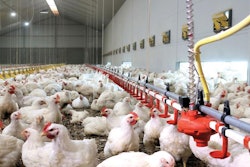
US feed industry hopes for a perfect harvest to stabilize ingredients costs, quell uncertainty in 2022
When I was writing my 2021 Feed Industry Outlook report for Feed Strategy’s December 2020 issue, all signs pointed to high commodity costs in the year ahead; however, it became clear by March 2021 the reality proved more turbulent than my sources predicted at the time.
Delving into the current state of grain costs and providing his take on what to expect into 2022, Wyatt Johnson, Land O’Lakes Inc.’s director of procurement and risk, examined the U.S. commodity market during his talk, “Market update on feed ingredients,” at the Midwest Poultry Federation Virtual Conference. Here’s a recap of the highlights.
Corn costs remain high for foreseeable future
The U.S. Department of Agriculture (USDA) reported U.S. corn prospective planting at 91 million acres this spring, but with the prospect of good crop conditions and high prices, Johnson believes it will incent additional acreage come the 2021 harvest.
“Corn is king today,” he reported. “Corn is strong and it’s here to stay.”
In 2021, tight supplies have been driven by a substantially lower 2020 yield/carryover crop and increased Chinese demand.
According to Johnson, corn futures and prices are being driven by two factors: additional risk due to weather with the 2021 crop and the outlook for sustained Chinese import volumes.
“We have to get to that whole growing cycle — without a drought and some nice cool nights — to increase that yield,” he says. “And then the second piece is that really around the Chinese demand that we talked about: Do they come to the market with a little more voracity than they want to?”
Soybean prices driven by biodiesel
Soybeans have experienced a similar scenario; however, the USDA has reduced export demand, “which is probably a pretty aggressive move when the balance sheet already has reduced demand built in,” he said.
“As we think about continued domestic demand, you think about recovering from African swine fever (ASF) going into next year,” Johnson said. “To me, I think exports being down year-over-year is a little bit of a challenge.”
“Because of crop years in both the U.S. and South America, [soybeans] are trading closer to true value,” he said. “Given that we’ve had a very tight soy situation and carryout for several months now, that same concern pushes through to the next crop year.”
Where typically high demand for protein drives a strong soybean market, in 2021, the demand for soybean oil for biodiesel has been the biggest driver.
“We’re crushing for oil, not meal,” he said. “Again, just that the nuance of this year versus the other years we had high prices. I don’t think the U.S. crop we’re planning right now alone can solve the protein and oil demand. It’s going to take a good U.S. crop this year, as well as another good South American crop, and once we get those things done back to back then I can think you can start thinking about soybean meal back at you know 300 or 320s. I don’t think you can get materially below 400 with those types of really tight carry-outs, really for the next six to nine months.”
China’s sway on grain stocks
Why does Johnson think grain prices will remain high? One main factor is Chinese imports of U.S. corn, soybean meal and wheat.
“If you look at all the imports this last crop year, [China’s] domestic prices have continued to rise both on corn and on soybean meal,” he explained. “Again, there is some volatility to it — and part of this is from African swine fever concerns — but overall, regardless, with all the imports they brought in, their domestic prices have still remained high. In my view, that means they needed the additional feedstuffs, they needed that protein, they needed that starch.”
For this reason, Johnson does not believe China will reduce its ingredient imports this next crop year.
“It is not often you get this tight of a balance sheet fixed simply in one year,” he said.
Micro-ingredient supply chain continues to grapple issues
In the past year, micro-ingredient supply chains have been struck with a slew of interruptions with shipping containers at points of origin and destinations to the ability for labor forces to run some of these plants and facilities during the height of the COVID pandemic.
“It’s all about logistics, logistics, logistics,” Johnson said. “As we continue to consolidate within the industries, you have a smaller supplier base so when there’s a breakout or a labor issue, it’s more impactful to the market. And then you have a world distribution model where things are coming from a lot further away so anytime you have a hiccup in your supply chain, the solve takes a lot longer because it’s not a truck and a day away.”
Strong soy and protein markets are overall supportive to amino acids in the next two years and probably supporting the majority of pricing, he noted.
“A lot of the amino acid supply is coming from China,” he explained. “Demand destruction from ASF made more local vitamins in China available for export. So that’s coming to the market, but again, perhaps some lower China prices being offset by that higher freight, higher logistics execution.”
Methionine costs continue to be high, but Johnson says there’s some light at the tunnel.
“Dry product availability is expected to prove here really over the next 30 to 60, even 90 days out, you can probably get what you need there. And again, a little bit less issues with liquid as a whole,” he said.
Vitamin E prices have spiked, but overall vitamin costs and supplies as a whole remain stable.
“I think the overall message from the marketplace and industry would be that you’re probably able to get what you need, but the prices are not super attractive,” he said. “But at the same time, until some of those supply chain interruptions are fully solved, there’s not a good reason that it’s likely to go down in a meaningful way for the next couple months. Expect them to stay elevated through the summer.”
2022 outlook hinges on the weather
Johnson expects corn prices to remain relatively volatile and high priced through the summer.
“We have to get through midpoint of the growing season — call it the Fourth of July — for [prices] to go down in a meaningful way,” he said.
He suggests keeping a close eye on the new crop and to slow down demand during the summer to shrink carry-in this fall.
“As you think about new crop trading above fundamental values — that is simply the premium put-in for a yield risk — so we can back off some of that demand, we can back off by adding some acres, but again, I’d expect to get through with the summer.”
Johnson noted that high soybean prices were driven by oil, not by soybean meal demand — and supplies will remain very tight.
He warns that if producers are “short meal basis and physical meal in the last half of July and harvest, it’ll get pretty tight, so make sure to keep in close contact with your suppliers and ownership on that.”
In Johnson’s opinion, the U.S. must have an excellent crop this summer and a solid South American crop in this fall to really solve the protein and oil problem for the U.S. in 2022.
“As you think about your forward projections, have the higher crop prices and input prices baked in for the next year,” Johnson said.
The Midwest Poultry Federation Virtual Conference was held May 18-21, 2021. To register to view on-demand recordings of the event, visit https://midwestpoultry.com/.


















